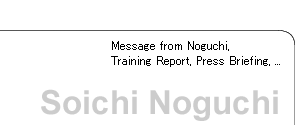Astronaut Noguchi's Training Report, #4
Space Foods
Last Updated: October 1, 2003
Space Food Tasting
 |
 |
 |
 |
| Space foods tasting by STS-114 crew members |
We were looking forward to the "Space Food Tasting" training that was conducted this month. Although the three daily food menus balance nutrients and calories, the astronaut's favorite is also fully considered because mealtime is one of the few times for busy astronauts to relax.
Since there is no food refrigerator in the space shuttle or on the International Space Station (ISS), space foods must be preserved for a long time. Space foods must also be easy to eat in a microgravity environment and must not scatter. For example, cracker crumbs that may scatter have been removed, and juicy foods have improved stickiness so they adhere to a spoon.
Space foods are made using three manufacturing (preservation) methods. The first is freeze-drying in which foods are dehydrated before eating. The second is to use a retortable pouch such as commonly used in foods like Japanese. These foods need only be heated in an oven before being eaten. The third method needs no processing, although foods have a limited preservation period. Such foods are said to be in the natural form, and include chocolate and bread.
 |
 |
| Examples of space foods |
NASA has about 200 kinds of space foods, and is incorporating foreign foods in anticipating of the ISS era. At this food tasting, we tasted about 50 kinds of foods and focused on adding new menu items. I will introduce some of them with my comments.
-
Mexican scrambled eggs: Spicy! And taste good.
-
Gumbo soup: Famous soup in Texas. Contains Gumbo and rice.
-
Beef enchiladas: Typical Mexican food also eaten in space.
-
Chicken salad: Healthy!
-
Vegetable risotto: I recommend this to vegetarians. Not so greasy.
-
Lasagna: Italian foods are also available. It was delicious because it included meat.
-
Sauteed tofu: Tofu is an international health food now but tofu eaten in Japan may be the most delicious.
-
Teriyaki chicken: Teriyaki and tofu are both popular in the United States.
Weren't you surprised at the menu variety? Since it seems that the kinds of space foods increase still more and will include astronauts' favorites and new foods, we may have the same kind of menus as restaurants in the near future.
The taste of Japan in space: Space foods proposed by Japan
There was one more food tasting trial. In preparation for Japanese astronauts' staying on the ISS, I brought several selected Japanese instant foods and had crew members try them.
 |
 |
| The expedition 4 crew and the crew of STS-110 ate curry in space |
The crew members tried Japanese tea, powdered soup, instant noodles, eel kabayaki (broiled eel), curry and rice, and dessert (sweet jelly of beans and chocolate confectionery). Although some crew members had not tried Japanese foods, they were pleased with these tastes, and said we should take the extra Japanese foods to the astronauts staying on in the ISS. (Actually, since the expedition 4 crew liked curry and rice, the requested curry was carried to the ISS).
 |
| What does it taste like in space? |
Instant noodles, as "ramen", were proposed in the Kibo utilization feasibility study through which NASDA(JAXA) solicited Kibo utilization. Although packing had to be improved, crew members rated the foods as very good. During the STS-114 mission, I'm going to eat "ramen" in space for the first time. Do noodles rehydrate as expected in a microgravity environment? Are noodles and soup mixed well? Is the taste good? Please wait for my "ramen" report from the ISS!





